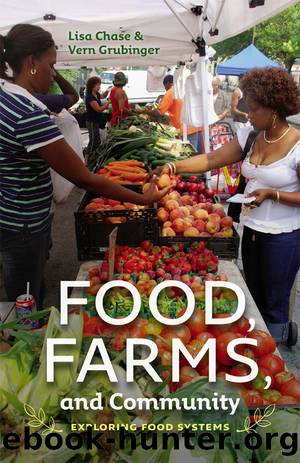Food, Farms, and Community by Lisa Chase

Author:Lisa Chase
Language: eng
Format: epub
Publisher: University of New Hampshire Press
Kids who participate in school meal programs get roughly half of their calories each day at school. . . . This is an extraordinary responsibility. But itâs also an opportunity.
Michelle Obama, First Lady of the United States
10 Farm to School
The growing interest in local food systems has led to âfarm-to-schoolâ programs, which aim to improve child nutrition while simultaneously enhancing local markets for farmers. These programs generally work on two levels: (1) increasing the use of healthy, locally sourced food in school cafeterias and (2) adopting educational programs that help kids understand and connect to where their food comes from as part of the effort to promote good eating habits.
While it is obvious that many factors beyond the school affect both child nutrition and local food purchasing, schools can have a significant influence on both. The USDA reports that almost 32 million kids consume more than 5 billion lunches during the nine-month school year as part of the national school lunch program, and nearly 13 million kids consume more than 2 billion breakfasts at school. More than two-thirds of these lunches and more than 80 percent of these breakfasts are provided for free or at a reduced price. All this costs the federal government almost $15 billion annually.1
The importance of providing healthy food to schoolchildren is one reason school food programs have been targeted for improvement. Specifically, these programs can use more local foods, including fresh, whole, unprocessed ingredients that have the potential to improve childrenâs dietary behavior by reducing their consumption of highly processed foods, which are often offered as part of school meals and snacks. Offering healthy food from any location is a good thing; adding the âlocalâ component can facilitate behavior change so that healthy food is actually consumed. âLocalâ may mean food from as close to the students as their own school garden, or it may come from nearby farms that students have some direct knowledge of or real connections with.
Sources of food that kids can seeâtheir gardens, the farms in their town or state, farmers who come to their classroomâcreate a platform for learning about agriculture and human nutrition as well as economics, environmental science, marketing, and much more. That learning may take place in the classroom, with a formal curriculum or through ad hoc lessons. It may also happen during field trips or in a hands-on school setting, which can be a garden but might also be a greenhouse, a âgrow labâ of lettuce under lights, or a cafeteria that features informational labels and posters, or perhaps a project to measure the volume of food waste that is diverted for composting. Farm-to-school programs are expanding (fig. 10.1), and they are introducing innovations, from âharvest of the monthâ menu offerings, to videos on the history of farming in town, to âhealthy harvestâ programs that get kids picking local fruits that will be frozen and later served by their school food service companies. To be most effective, these programs combine a variety of approaches aimed at
Download
This site does not store any files on its server. We only index and link to content provided by other sites. Please contact the content providers to delete copyright contents if any and email us, we'll remove relevant links or contents immediately.
Craft Beer for the Homebrewer by Michael Agnew(18140)
Marijuana Grower's Handbook by Ed Rosenthal(3619)
Barkskins by Annie Proulx(3300)
Project Animal Farm: An Accidental Journey into the Secret World of Farming and the Truth About Our Food by Sonia Faruqi(3176)
The Plant Messiah by Carlos Magdalena(2881)
Red Famine: Stalin's War on Ukraine by Anne Applebaum(2872)
0041152001443424520 .pdf by Unknown(2783)
Organic Mushroom Farming and Mycoremediation by Tradd Cotter(2626)
In the Woods by Tana French(2530)
Beer is proof God loves us by Charles W. Bamforth(2370)
7-14 Days by Noah Waters(2360)
Reservoir 13 by Jon McGregor(2239)
Borders by unknow(2227)
Meathooked by Marta Zaraska(2220)
The Art of Making Gelato by Morgan Morano(2216)
Birds, Beasts and Relatives by Gerald Durrell(2175)
Between Two Fires by Christopher Buehlman(2163)
The 7 Habits of Highly Effective People: Powerful Lessons in Personal Change (25th Anniversary Edition) by Covey Stephen R(2138)
The Lean Farm Guide to Growing Vegetables: More In-Depth Lean Techniques for Efficient Organic Production by Ben Hartman(2096)
